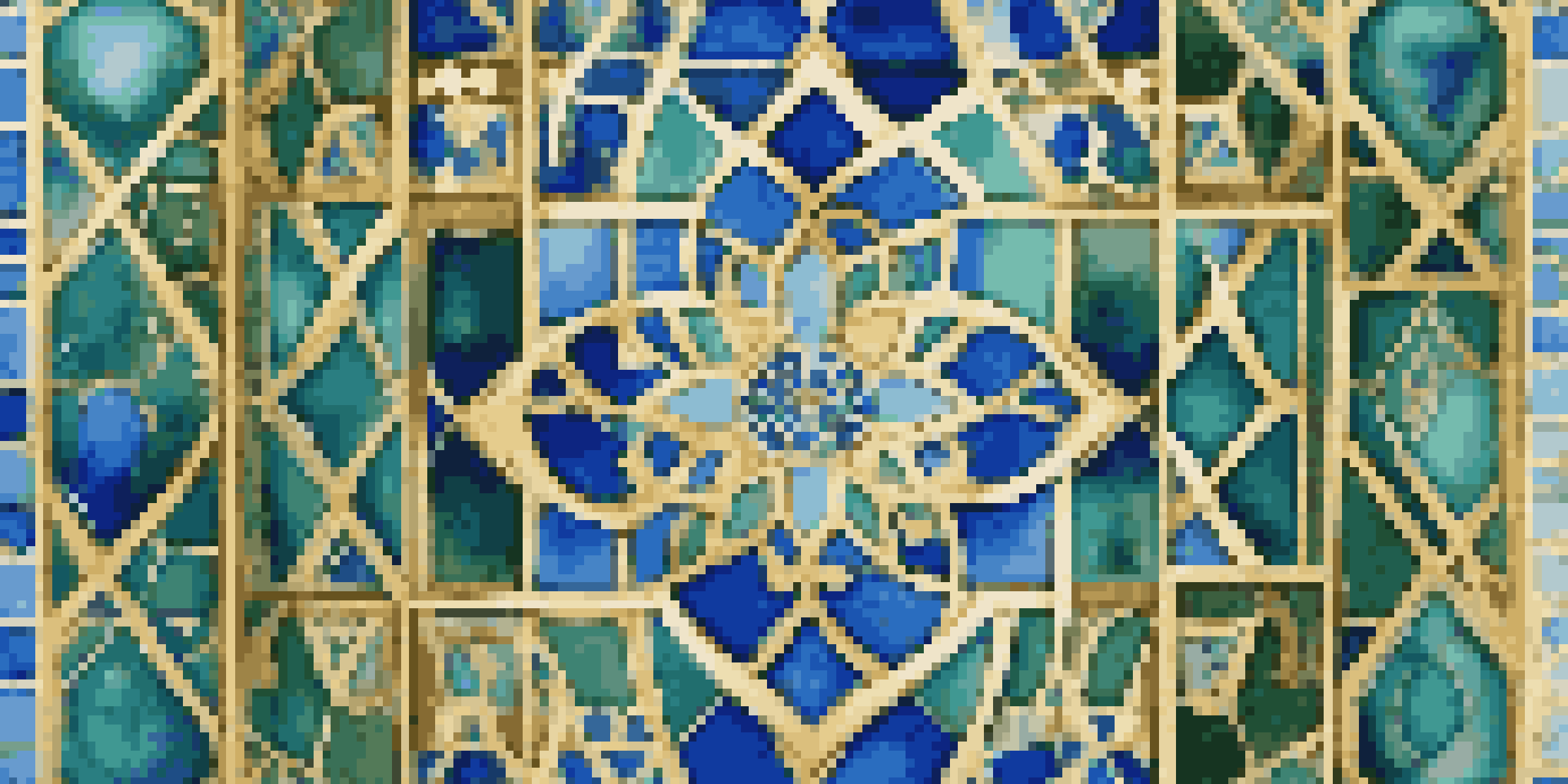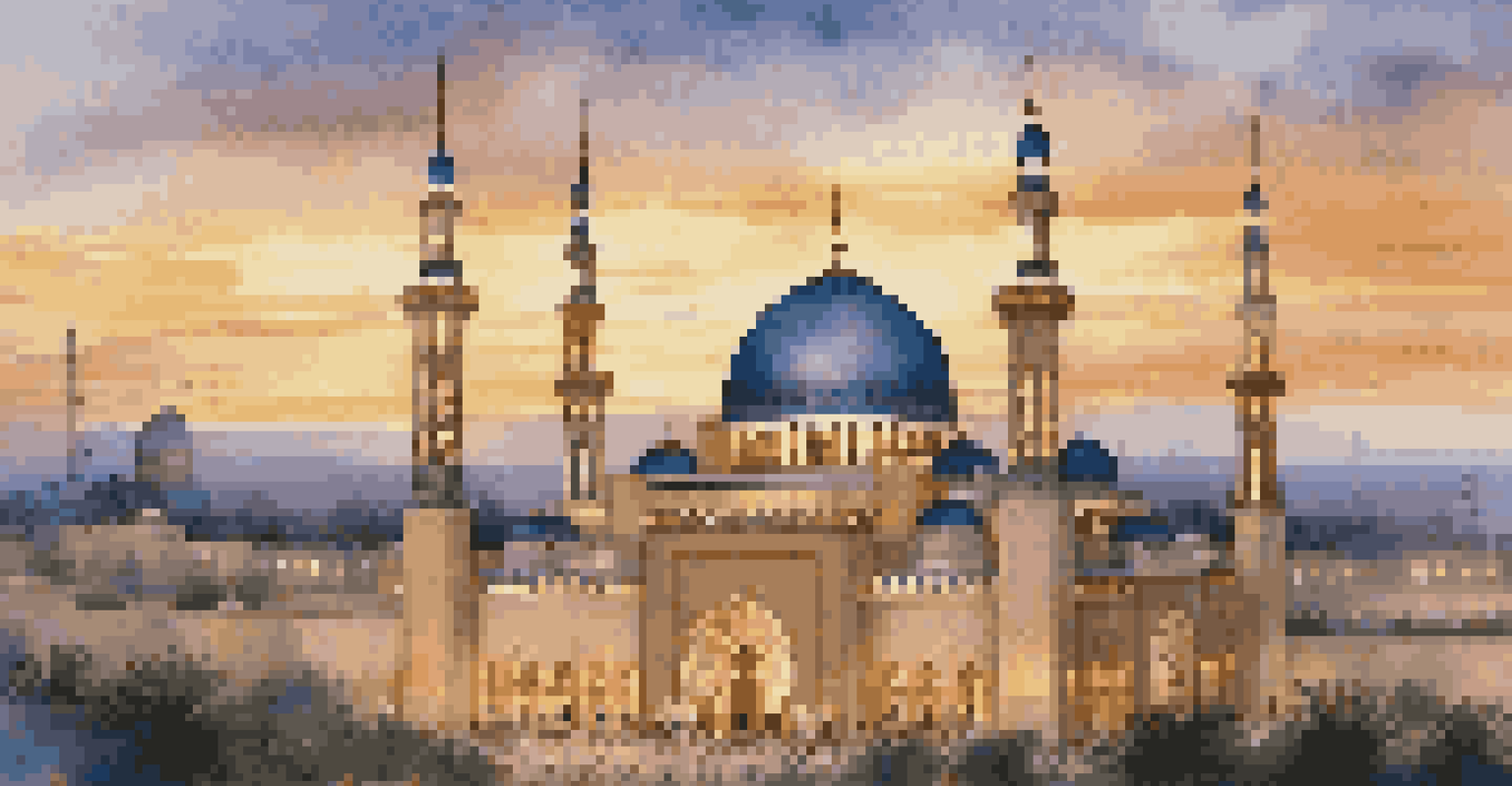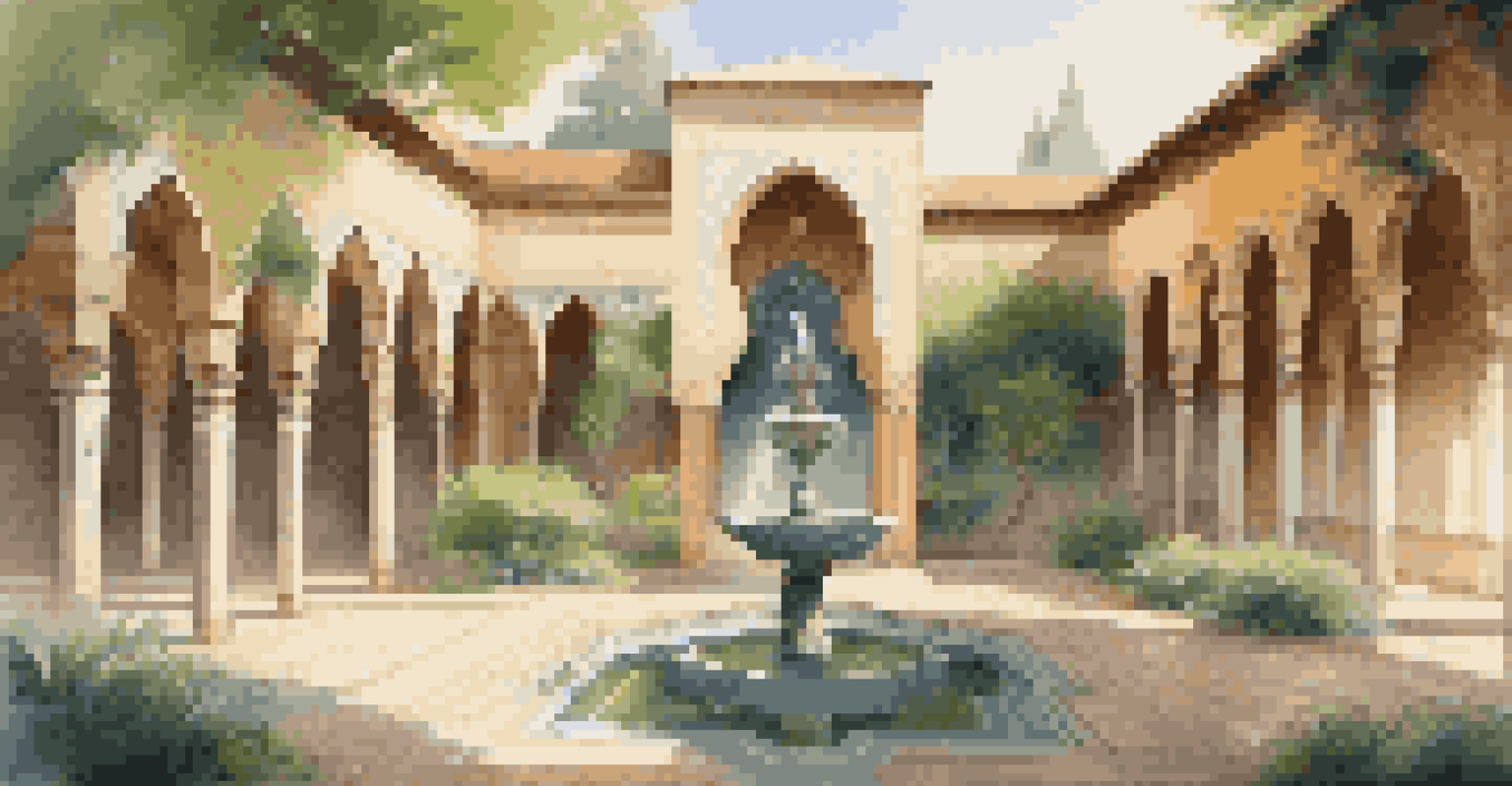Exploring the Aesthetics of Islamic Art and Architecture

The Essence of Islamic Art: A Cultural Reflection
Islamic art is more than just beautiful objects; it reflects the rich tapestry of Islamic culture and history. It often emphasizes the beauty of the divine, showcasing themes of spirituality and connection to God. This cultural lens is vital as it offers insights into the values, beliefs, and practices of diverse Islamic societies.
Islamic art is a reflection of the universality of the human experience, transcending borders and cultures.
The art form is characterized by intricate patterns, vibrant colors, and a strong sense of geometry. These elements symbolize the infinite nature of Allah, making each piece not just visually stunning but also deeply meaningful. By studying these patterns, one can appreciate how they bridge the earthly and the spiritual.
Moreover, Islamic art transcends borders, incorporating influences from various regions such as Persia, the Ottoman Empire, and North Africa. This diversity enriches Islamic art, allowing it to resonate with a wider audience and inviting deeper exploration of its cultural significance.
Key Characteristics of Islamic Art: Patterns and Motifs
One of the most recognizable features of Islamic art is its intricate geometric patterns. These designs serve not just an aesthetic purpose but also convey a sense of order and harmony, reflecting the universe's complexities. For instance, you might notice that these patterns often repeat infinitely, symbolizing the eternal nature of creation.

Another hallmark of Islamic art is the use of arabesques—ornamental designs that intertwine foliage and floral patterns. These motifs illustrate the beauty of nature and are often seen in manuscripts, ceramics, and architecture. They not only beautify spaces but also invite contemplation and reflection.
Cultural Reflection in Art
Islamic art embodies the values and beliefs of diverse Islamic societies, showcasing a rich tapestry of culture and spirituality.
Calligraphy is another vital aspect, often seen as the highest form of artistic expression in the Islamic world. Verses from the Quran are beautifully inscribed on walls and artifacts, merging spiritual significance with artistic flair. This intertwining of art and faith creates a unique dialogue that enhances the viewer's experience.
Islamic Architecture: A Journey Through Time
Islamic architecture is a visual narrative, telling stories of faith, culture, and innovation. From grand mosques to simple homes, each structure embodies the principles of beauty and functionality. The Great Mosque of Samarra, with its spiraling minaret, exemplifies how architecture can convey a sense of spirituality while meeting communal needs.
Art is a way of expressing the unexpressable, and in Islamic art, this is achieved through patterns, colors, and forms that evoke the divine.
The use of domes and arches is prevalent in Islamic architecture, creating spaces that inspire awe and tranquility. The iconic dome serves as a symbol of the heavens, while arches provide structural stability and an open, inviting atmosphere. This architectural style invites worshippers and visitors to experience a connection with the divine.
Moreover, the incorporation of courtyards in Islamic buildings promotes a sense of community and reflection. These open spaces often feature beautiful gardens and fountains, enhancing the overall aesthetic and providing a peaceful retreat. Thus, Islamic architecture not only serves a practical purpose but also enriches the cultural landscape.
The Role of Color in Islamic Art and Architecture
Color plays a profound role in Islamic art and architecture, often symbolizing various emotions and spiritual concepts. Rich blues and greens are frequently used, representing paradise and spirituality. These colors draw the eye and resonate with viewers on a deeper level, enhancing their experience of the artwork.
The vibrant palette found in tile work, textiles, and decorative elements serves to elevate the visual impact of Islamic structures. For example, the intricate tile mosaics seen in places like the Shah Mosque in Isfahan create a mesmerizing effect, immersing visitors in a world of color and design. This use of color not only beautifies but also communicates the grandeur of Islamic culture.
Symbolism and Meaning
Each design element in Islamic art carries deeper meanings, such as the crescent moon symbolizing light and guidance.
Moreover, the thoughtful combination of colors can evoke specific feelings, creating a tranquil or vibrant atmosphere depending on the context. This intentional use of color reflects the artist's skill and understanding of how visual elements can influence emotions and perceptions.
Symbolism in Islamic Art: Beyond the Surface
Symbolism is a key aspect of Islamic art, where every design element carries deeper meanings. For instance, the use of the crescent moon and star symbolizes light and guidance, often associated with Islam itself. Recognizing these symbols allows viewers to engage more profoundly with the artwork.
The number eight, represented in many patterns, is also significant as it can symbolize the heavens and the eight angels that hold up the throne of Allah. This layer of meaning enriches the viewer's experience, encouraging exploration of the underlying messages within the artwork.
Additionally, the absence of human figures in religious Islamic art is intentional, guiding the focus toward the divine rather than earthly representations. This choice promotes an appreciation for the beauty of creation without distraction, reinforcing the spiritual essence of the art form.
Influences and Cross-Cultural Exchanges in Islamic Art
Islamic art has evolved through centuries of cultural exchange, absorbing influences from various civilizations. The Silk Road played a pivotal role in this exchange, facilitating the movement of ideas, techniques, and materials across regions. This interconnectedness enriched Islamic art, making it a melting pot of diverse styles and traditions.
For example, the incorporation of Chinese porcelain into Islamic ceramics showcases this cultural dialogue. Such exchanges not only inspired new artistic techniques but also fostered mutual appreciation between different cultures. The result is a dynamic art form that reflects the history of human interaction and creativity.
Modern Expressions of Tradition
Contemporary Islamic art merges traditional themes with modern mediums, keeping the cultural heritage alive while appealing to today's audience.
The influence of Byzantine art is also evident in Islamic mosaics and architecture, particularly in the use of domes and intricate tile work. This blending of styles illustrates how Islamic artists adapted and transformed existing ideas, creating something uniquely their own while honoring their cultural heritage.
Contemporary Expressions of Islamic Art
In today's world, Islamic art continues to thrive, evolving while staying true to its roots. Contemporary artists are exploring traditional themes through modern mediums, merging the past with the present. This blend of styles not only honors the legacy of Islamic art but also makes it relevant to today's audience.
Street art and digital installations are emerging as popular forms of expression among young artists. These new platforms allow for bold interpretations of Islamic motifs and themes, fostering a dialogue between tradition and innovation. This evolution showcases how Islamic art can adapt to contemporary challenges while remaining deeply connected to its cultural heritage.

Moreover, exhibitions worldwide are providing a stage for these contemporary voices, allowing for a broader appreciation of Islamic art. By showcasing diverse perspectives, these exhibitions enrich our understanding of Islamic culture and highlight the ongoing relevance of its artistic expressions.